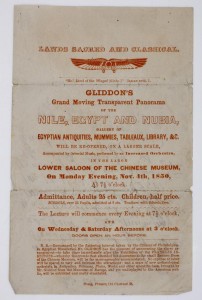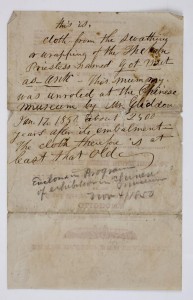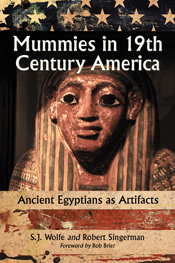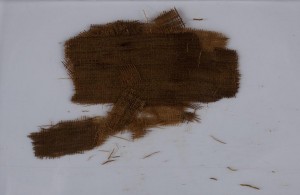While most people today are familiar with Egyptian mummies through various sorts of media — books, television, films, supermarket tabloids, museum exhibitions and the ubiquitous Halloween decorations — people in mid-nineteenth century America did not have this same experience. To them, mummies were rare, mysterious relics, most often associated with the Biblical past, and few had ever actually seen one in the flesh, as it were.
Indeed, the continentals had it all over their American counterparts, for mummies had long been a very public institution, particularly in England, where it was not uncommon for a mummy unwrapping to be a high society event, accompanied by an elaborate dinner, after which the unfortunate relic would be unceremoniously despoiled of its linen cerements in hopes that something along the lines of valuable collectables, such as amulets or jewelry, might be found. How many of these ancient Egyptians suffered this indignity and to what fate their remains were eventually consigned is not known, but it may well have been hundreds or more.
In the United States, fewer mummies were imported, owing chiefly to a ban on their export by the Pasha in 1835, and what unwrappings were performed were chiefly public events in front of medical or scientific audiences. The first such unwrapping was in December 1824, at New York’s Castle Garden, where a mummy procured by Captain Larkin Thorndike Lee was unwrapped and pronounced genuine and female. Lee then consigned the mummy and exhibition rights to a Mr. Bishop, who briefly exhibited the mummy in New Jersey and Pennsylvania, and then absconded with both the artifact and the money. In the mid 1830’s Rubens Peale and John Scudder, rival museum entrepreneurs in New York each advertised a mummy unwrapping, which would be limited to audiences of adult men only, the subject being deemed inappropriate for women and children.
Then in 1850, George Gliddon, Egyptologist, former consul in Egypt and lecturer, proposed a mummy unwrapping in Boston at Tremont Temple. He had obtained the mummies with much difficulty and expense from Egypt and London, after losing a dozen mummies, previously purchased, to the vagaries of the Egyptian Customs Office, which had lagged so long in their deliberations about allowing Gliddon to take them out of the country that they crumbled to bits in a storage shed. Nevertheless, Gliddon was able to scrounge up four mummies, which he used as an adjunct exhibition to his “transparent” Panorama of the Nile. The Boston unwrapping was a means to promote both the panorama and Gliddon as an authority on Egypt.
The announcement featured representations of two mummies and their coffins, and Gliddon postulated that the one he was going to unwrap in Boston was a priestess of Thebes, as evidenced by the inscriptions on her coffin, which gave her name as ASCH-ph*****, some of the hieroglyphics being unreadable. This was seized upon with serious interest as the Bostonians signed up for the three-day course of lectures during which the unwrapping would occur. One anonymous poet even penned a lengthy ode in which he describes the beautiful young woman’s untimely death, and how her beloved “weeps upon the broken stem of the lily of the Nile.” By the time of the opening, the priestess was also a princess and excitement was rife. Various notables were in attendance, including Louis Agassiz, who helped with the unwrapping. All went splendidly until the third and final evening, when Glid don got the surprise of his life as the mummy turned out to be male, “exhibiting in its fossil state the erected unequivocal mark of its sex.” Quick-thinking Gliddon had an explanation, blaming the gaffe on drunken coffin makers and embalmers, but he never quite lived down that moment of infamy.
don got the surprise of his life as the mummy turned out to be male, “exhibiting in its fossil state the erected unequivocal mark of its sex.” Quick-thinking Gliddon had an explanation, blaming the gaffe on drunken coffin makers and embalmers, but he never quite lived down that moment of infamy.
Shortly thereafter Gliddon packed up the Panorama of the Nile and the mummies, and went to Philadelphia, where on 23 November 1850, underneath a picture of the coffin and mummy of Got-Mut-As-Anch, he issued a similar proposal to the one he had issued in Boston, except that he would unroll TWO mummies, the other one being a nameless child. He also issued a small handbill printed in red ink, advertising the display of the Panorama of the Nile, in the Lower Saloon of the Chinese Museum. Before the lectures, Gliddon exhibited the mummies and some visitors were startled to hear the words coming from the one which had been unwrapped in Boston!
echoed throughout the room. There followed a dialogue between the observers and the mummy, which covered the decline of the Egyptian Empire and strongly hinted that the ancient inhabitants thereof had migrated to Mexico, there to continue their pyramid building habits. This was of course, a hoax, perpetrated by the famous ventriloquist Bobby Blitz, who reaped such fun from his folderol that he later incorporated a mummy in his performances.
The lectures and unwrappings went without a hitch, and one anonymous onlooker was able to obtain a length of the linen wrapping of Got-Mut-As-Anch, carefully recording the authenticity of the  piece before folding it in a copy of the small broadside as a souvenir. The American Antiquarian Society now owns both the flier and the linen, a remarkable acquisition under any circumstances.
piece before folding it in a copy of the small broadside as a souvenir. The American Antiquarian Society now owns both the flier and the linen, a remarkable acquisition under any circumstances.
After his sojourn in Philadelphia, Gliddon eventually made his way to New Orleans where he unwrapped the final mummy. He then presented the mummy to the University of Louisiana, to be placed in the museum of the medical school—later Tulane University.
This mummy was given the name “Nefer Atethu” or “Beautiful youth” many years later during a radiological study of her and Got-Thoti-Aunk (the mummy unwrapped in Boston), who had also been given to the museum in 1851 by Gliddon and Josiah C. Nott (who had collaborated on the writing of Types of Mankind).
The two mummies and their coffins were stored in various locations, including a space under the bleachers in the football stadium. They attended three Super Bowl games (and numerous college games) before being rescued, in the mid 1970’s, and placed in a somewhat more appropriate setting at the college. According to Samuel Morton’s catalogue of skulls, the head of Got-mut-as-Anch was given to him for that collection. I t is not known what happened to the rest of the body, nor to the child’s mummy unwrapped in Philadelphia.
t is not known what happened to the rest of the body, nor to the child’s mummy unwrapped in Philadelphia.
A more extensive telling of this story appears in the chapter “Unholy unrollers” in my book Mummies in Nineteenth Century America; Ancient Egyptians as Artifacts (McFarland, 2009) which is a discussion of how Egyptian mummies came to America and what happened to them after they got here as they progressed from being viewed as curiosities, to being exploited as commodities, and finally their ongoing role as cultural connections to a world long past.
By S.J. Wolfe, senior cataloguer and serials specialist, American Antiquarian Society.


Congratulations on another interesting article Su!
I am constantly surprised to find that popular – usually American – myths about mummies turn out to have some basis in reality, given the strange uses to which mummies were once put. An episode of “The Simpsons” featured a cinema trailer for a fictitious film called “Soccer Mummy”, in which a revived mummy plays on a college soccer team. This seems to encapsulate some cultural memory of mummies owned by colleges being (mis)used as sports mascots, as in the present case. Then there was the sad case of the “blockhead coffin” and its resident being carried around by college students until they fell to bits …
It is appalling that mummies were so badly abused in some institutions as late as the 1970s; meanwhile in Manchester, the first modern multidisciplinary mummy research was beginning. The poor mummies still resident by then in some non-museum institutions were still being subjected to 19th century forms of predation.
Thanks, Jazz, pertinent as always!
Su
Hi! What is known about the Egyptian mummy that was on exhibit at Scudder’s American Museum in New York City in 1835? Thanks!
Scudder’s mummy is a bit of an enigma, as it shows up rather out of nowhere about the same time as Rubens Peale buys two and sells one (but not to Scudder) The Scudder mummy may be either one brought in in 1824 by Capt. Larkin T. Lee (and which had a very checkered life, finally being sold by Jessee Sharpless) Or it may be Larkin Turner’s mummy (the men are no relation) which was bought by Etha Allen Greenwood and then exhibited all over New Englsnd. It was unwrapped by Scudder but the details are sparse. After Scudder it may have gone to PT Barnum. There are no known extant pictures of the mummy and the descriptions of all of these early mummies are very vague. I cover Scudder’s mummy in my book Mummies in Nineteeth century America (see above) that will give you a better answer than I can give you in this short space. If you have further questions, please do not hesitate to contact me directly at AAS.
SJ Wolfe
Thank-you very kindly for this helpful information. I deeply appreciate your help.